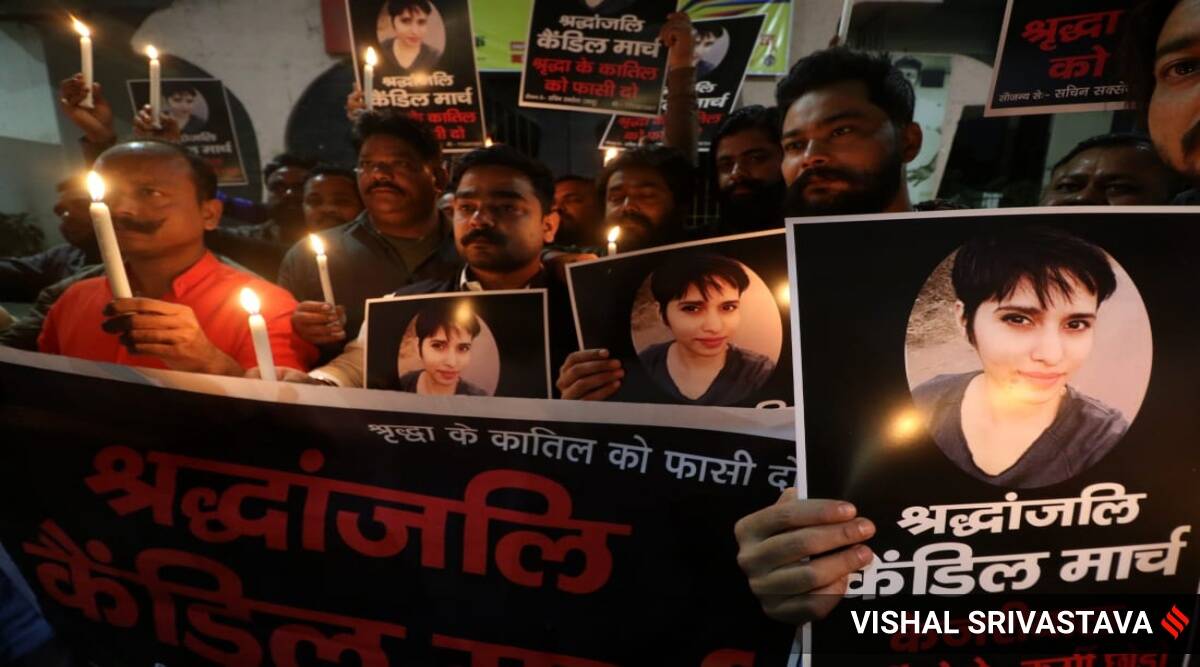
NCB 2021 reports that every hour 49 offences are committed against women in India. Seventy five per cent of the perpetrators of violence against women go unpunished mainly because of immunity granted to them by a casteist and patriarchal system
In the context of gruesome Shraddha murder, we must ponder over as to how safe are women inside their home? Is there life beyond the maternal home? Why has the accused’s religion and the word ‘live-in’ has hogged the limelight than the societal mindset?
It was not long ago that courts held the live-in relationship legal. However, in this case the narrative has been weaved around putting the blame on the live-in relationships. This simply amounts to moral policing and holding the women victims responsible for the crime. Little sympathy for the young woman, nor pricking the conscience of society but finding fault with the victim. Shraddha fell in love with Aftab at Mumbai, came to Delhi but found that she was not safe even at her chosen ‘home’. She was strangled to death by her loved partner who chopped her body into 35 pieces, stored it in a fridge and used the silence of city nights to spread the body parts across the Lutyens Delhi.
Cases show a pattern
Around the time this terrible crime was detected in Delhi, in Azamgarh in Uttar Pradesh, a young woman was killed and cut into six parts by her ex-boyfriend. Another woman in Sitapur district was killed by her husband and her body hacked into pieces and dumped in a field. The communalisation of violence against women in India is a highly dangerous weapon which will further subvert the judicial process and rendering of justice. In The Bilkis Bano case, the affidavit of the Gujarat government in the petition opposing the release of the gang rapists and killers specifically mentions that before their release, sanction was given by the union home ministry.
When union minister Kaushal Kishore suggested that the ‘educated women’ should get registered first before staying away with the ‘live in partners’ , it amounted only to our masculine beliefs. Had they got registered, would she be able to save her life?
As per the data of National Commission for Women (NCW), the domestic violence complaints whereas in the first week of March before the lockdown was imposed stood at 30; it shot up to 69 in the first week of lockdown only (March 23- April 1). The rising complaints led to NCW starting a WhatsApp number for registering complaints. The root of the violence is the patriarchal family structure. It must be understood that domestic violence is an undeclared war against women which has taken more victims through the years than any conventional war.
Five years ago, the #MeToo movement exploded, sparking global mobilization in preventing and responding to violence against women and girls but thereafter, it was back to square one. In fact there has been a rise in anti-feminist groups and a rise in attacks against women human rights defenders and activists. The answer lies in the existing social structure ridden with misogyny when women are often socially ostracised for making their choices without their parents, and crossing the boundaries set by the family structure. When abused and away from the paternal home, often women withdraw themselves for making a wrong ‘choice’. Little doubt, the abuser goes scot-free, and the sufferer continues to suffer.
The recent revelation about Shraddha that she was admitted to hospital in Mumbai with bruises in 2020, far before she came to Delhi indicates that she has been into this abusive relationship for long. The reports suggest that she filed a report with the police but later withdrew it when police came to check with the couple.
A woman killed every 11 minutes
Ahead of International Day for the Elimination of Violence Against Women on November 25, the United Nations chief António Guterres urged world leaders to increase funding by 50 per cent to women rights organisations and movements by 2026. In his message, he said that every eleven minutes, a girl or a woman is killed by an intimate partner or family member. Calling for a collective action towards ending violence against women, he said, “Now is the time for transformative action that ends violence against women and girls.” Guterres further said, “Let’s proudly declare: We are all feminists.”
A report titled “Progress on the Sustainable Development Goals: The gender snapshot 2022” published by the United Nations Women and the UN Department of Economic and Social Affairs in September this year had identified gender-based violence against women as one of the factors that could delay achieving global gender equality by 286 years. The report highlighted that one in every 10 women and girls aged 15-49 across the world was subjected to sexual and/or physical violence by an intimate partner in 2021.
In India, the rate of reported cases of cruelty by husbands and relatives marked an increase of 53 per cent between 2001 and 2018, with the middle socio-demographic index states housing the highest burden of this crime. “A total of 15,48,548 cases were reported under cruelty by husband or his relatives over 18 years from 2001 to 2018, with 5,54,481 (35.8 pc) between 2014 and 2018 alone.
The reported rate of this crime in India was 18.5 in 2001 and 28.3 in 2018 per 100,000 women aged 15–49 years, marking a significant increase of 53 pc over this period, finds the study published in BMC Health, an open access peer reviewed journal on health services.
The National Crime Bureau 2021 reports that on an average, every day, 86 women are raped and whose cases are registered. Every hour there are 49 offences committed against women registered under the IPC, every day on an average 18 women lose their lives in dowry related domestic violence— 6,589 dowry deaths registered in a single year. The National Family Health Survey- 5 shows that one third of all women surveyed said they had faced domestic or sexual violence.
The statistics should make any country hang its head in shame. But in India there has not been a single word from the government. One of the causes is that perpetrators of violence have an immunity granted to them by a casteist and patriarchal system due to which 75 per cent of perpetrators of violence against women remain unpunished. This low rate of conviction is directly a result of biased investigations by the police, long delays in the court system and social pressures on the survivors of violence to compromise. There is a need to intensify the struggle to defend the rights of women guaranteed in the constitution and to enforce the laws against violence on women must be waged with renewed vigour.












